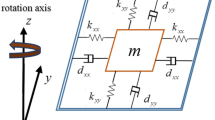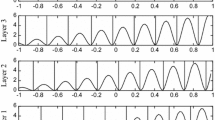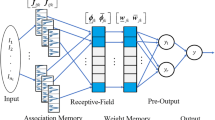Abstract
Conventionally, least mean square rule (LMS) is used to update the weights of cerebellar model articulation controller (CMAC). The algorithm of CMAC-RLS which applies recursive least square algorithm (RLS) to update the weights of CMAC has proved to be a good tool for modeling on line. Based on QR decomposition, a simplified algorithm of CMAC-RLS named CMAC-QRLS is brought forward next and its corresponding systolic array is also designed. Combining with B-splines, we further devise the systolic array of continuous CMAC-QRLS. The simulation results reveal the good performance of this proposed algorithm.
Similar content being viewed by others
Explore related subjects
Discover the latest articles, news and stories from top researchers in related subjects.References
J.S. Albus (1975) ArticleTitleA new approach to manipulator control: The cerebellar model articulation controller (CMAC) Trans. ASME, J. Dyn. Syst., Meas. Control. 97 220–227
J.S. Albus (1975) ArticleTitleData storage in the cerebellar model articulation controller (CMAC) Trans. ASME, J. Dyn. Syst. Means. Control. 97 228–233
C.-T. Chiang C.-S. Lin (1996) ArticleTitleCMAC with general basis functions Neural Netw. 9 1199–1211 Occurrence Handle10.1016/0893-6080(96)00132-3 Occurrence Handle12662593
S.H. Lane D.A. Handelman J.J. Gelfand (1992) ArticleTitleTheory and development of higher-order CMAC neural networks. IEEE Control Syst. Mag., 12 23–30
P.C. Parks J. Militzer (1989) ArticleTitleConvergence properties of associative memory storage for learning control system Automat. Rem. Control,. 50 254–286
Y.-F. Wong A. Siders (1992) ArticleTitleLearning convergence in the cerebellar model articulation controller IEEE Trans. Nerural Netw. 3 115–121 Occurrence Handle10.1109/72.105424
C.-S. Lin C.-T. Chiang (1997) ArticleTitleLearning convergence of CMAC technique IEEE Trans. Neural Netw. 8 1281–1292 Occurrence Handle10.1109/72.641451
C. He L. Xu Y. Zhang (2001) ArticleTitleLearning Convergence of CMAC Algorithm Neural Process. Lett. 14 61–74 Occurrence Handle10.1023/A:1011382225296
Jar-Shone K., Hwang K.Y., Bin-Da L. Hardware realization of higher-order CMAC model for color calibration, Proceedings of IEEE International Conference on Neural Netwokrs, Perth, WA, Australia, 11/27/1995–12/01/1995, pp. 1656–1661
Miller W.T., Latham P.J., Scalera S.M. Bipedal Gait Adaptation for Walking with Dynamic Balance, Proceedings of the 1991 American Controls Conference, Boston, MA, June, 1991. Vol. 2, pp. 1603–1608
W.T. Miller F.H. Glanz L.G. Kraft (1987) ArticleTitleApplication of a general learning algorithm to the control of robotic manipulators Int. J. Robot. Res. 6 84–98
W.T. Miller (1989) ArticleTitleReal-time application of neural networks for sensor-based control of robots with vision IEEE Trans. Syst., Man Cybernetics. 19 825–831
W.T. Miller R.P. Hewes F.H. Glanz L.G. Kraft (1990) ArticleTitleReal-time dynamic control of an industrial manipulator using a neural-network-based learning controller IEEE Trans. Robotics Automat. 6 1–9 Occurrence Handle10.1109/70.88112
Manglevhedakar S. (1986). An adaptive hierarchical model for computer vision. Thesis, Louisiana State University.
A. Kolcz N.M. Allinson (1994) ArticleTitleApplication of the CMAC input encoding scheme in the N-tuple approximation network IEE Proc. Comput. Digit Tech. 141 177–183 Occurrence Handle10.1049/ip-cdt:19941004
T. Qin Z. Chen (2004) ArticleTitleA learning algorithm of CMAC based On RLS Neural Process. Lett. 19 49–61 Occurrence Handle10.1023/B:NEPL.0000016847.18175.60
Haykin S. Adaptive Filter Theory, Prentice Hall, 2002.
B. Yang J.F. Bohme (1992) ArticleTitleRotation-based RLS algorithms: Unified derivations, numerical properties, and parallel implementations IEEE Trans. Signal Process. 40 1151–1167 Occurrence Handle10.1109/78.134478
Shengfu W. Spline Function and their Application, Northwestern Polytechnical University Press, 1989.
H. Khalil (2002) Nonlinear Systems, third edition Prentice-Hall Upper Saddle River, NJ
Author information
Authors and Affiliations
Corresponding author
Rights and permissions
About this article
Cite this article
Qin, T., Zhang, H., Chen, Z. et al. Continuous CMAC-QRLS and Its Systolic Array. Neural Process Lett 22, 1–16 (2005). https://doi.org/10.1007/s11063-004-2694-0
Issue Date:
DOI: https://doi.org/10.1007/s11063-004-2694-0




